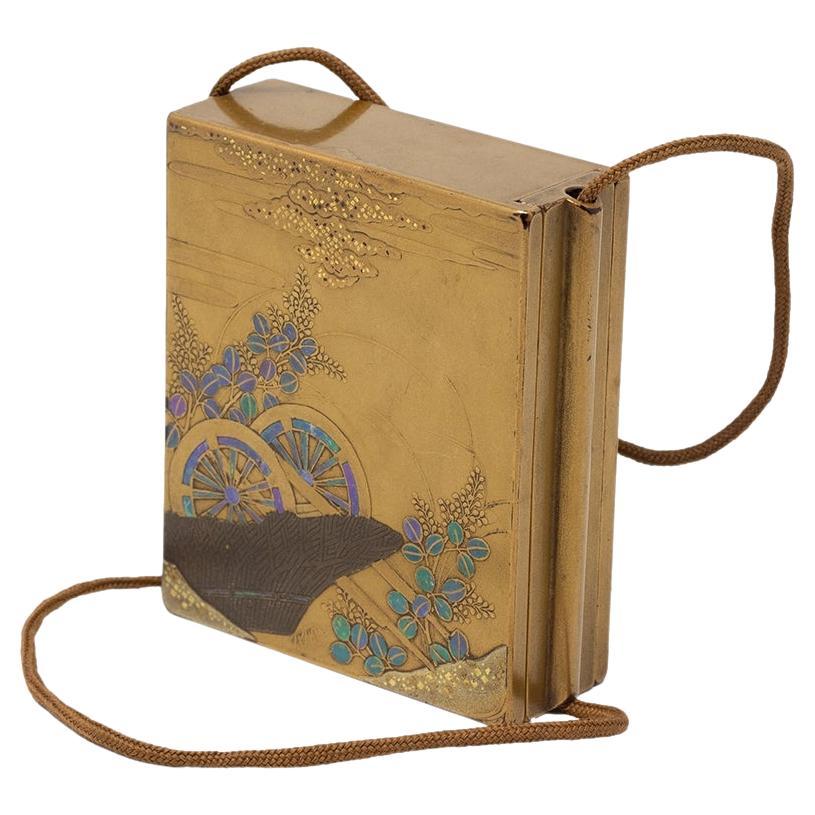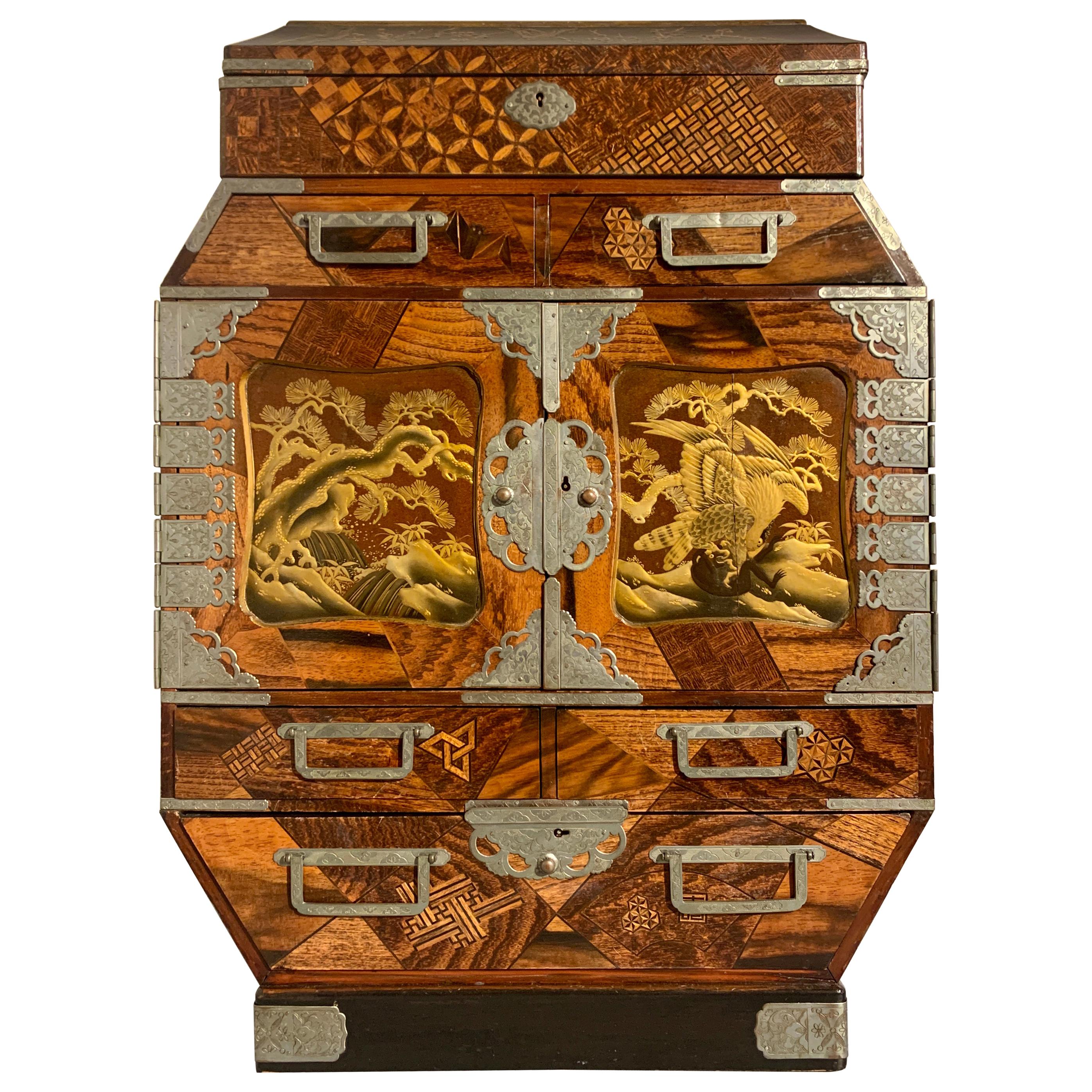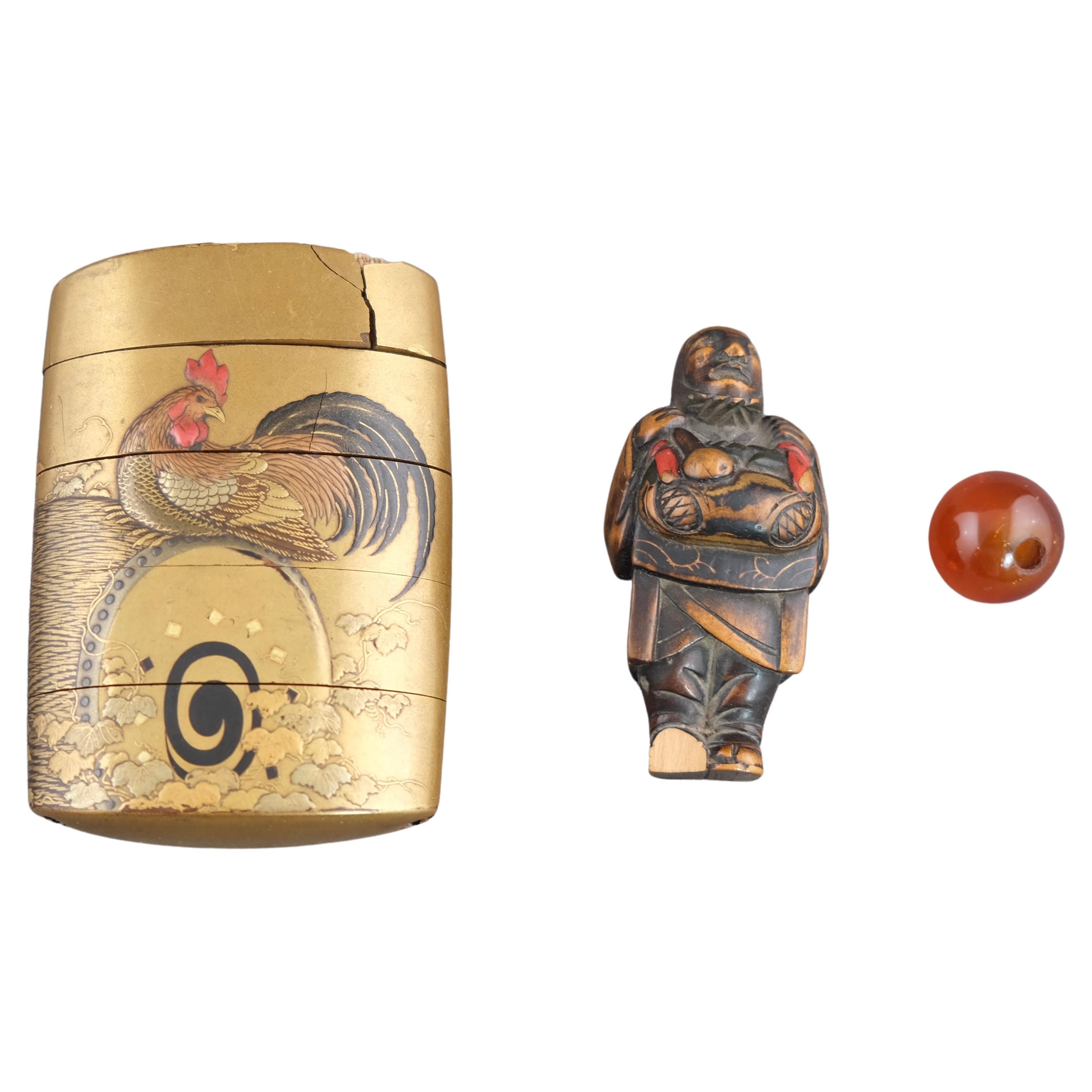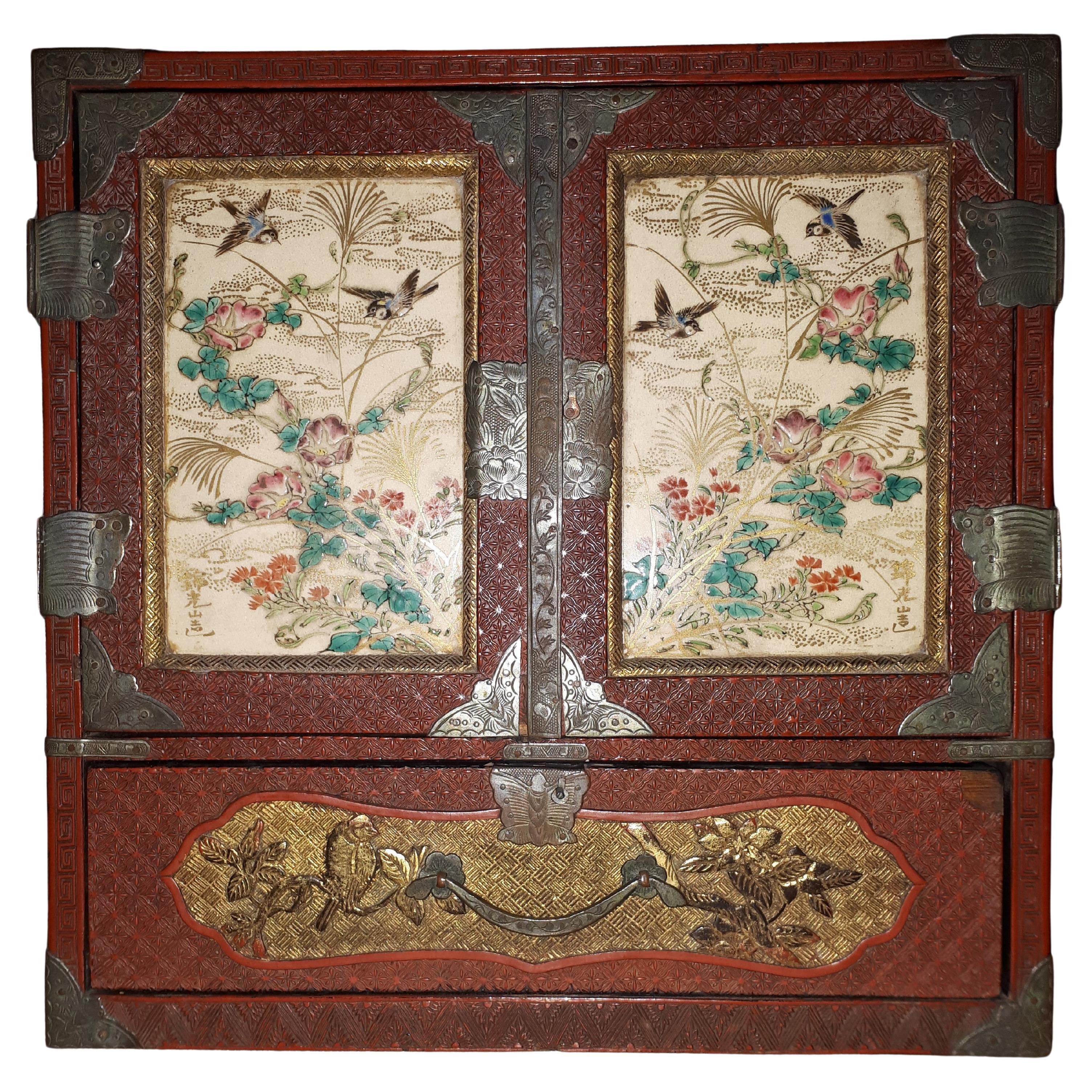Items Similar to Japanese Carved Cinnabar Lacquer Inro, Meiji Period, late 19th c, Japan
Want more images or videos?
Request additional images or videos from the seller
1 of 12
Japanese Carved Cinnabar Lacquer Inro, Meiji Period, late 19th c, Japan
About the Item
A good Japanese carved cinnabar three case inro with mixed metal ojime, Meiji period, late 19th century, Japan.
The three case inro of standard form, comprised of three container sections and a cover, strung on a red silk cord, and secured with a mixed metal ojime bead.
The inro carved all over in a dense geometric pattern of octagons, each with a carved blossom in the center, and rhombuses to the corners. This pattern is based on a brocade pattern, called kikko, representing longevity. The octagonal shape is thought to resemble the patterning of a tortoise shell. Tortoises are symbols of longevity in Japan.
The interior compartments of the case with a maki-e lacquer nashiji ground for the risers, vermillion red lacquer for the compartment interiors, and a gold lacquer ground, fudame, for the rims and shoulders.
The mixed metal ojime slide of cylindrical shape with a checked pattern of mixed metals. This pattern is also based on a brocade pattern, and is known as ichimatsu.
Inro are a uniquely Japanese object. Because traditional Japanese kimono do not have pockets, inro were developed to hold personal seals, medicine, and other small items. They were hung from the obi, and secured with netsuke and ojime. While functional, they also served as symbols of status, wealth, and power. Inro were almost certainly the inspiration for the small vanity cases, necessaires, that were developed and popularized in the Art Deco period.
- Dimensions:Height: 3 in (7.62 cm)Width: 2.25 in (5.72 cm)Depth: 0.63 in (1.61 cm)
- Style:Meiji (Of the Period)
- Materials and Techniques:
- Place of Origin:
- Period:
- Date of Manufacture:late 19th century
- Condition:Wear consistent with age and use. Minor fading. In overall good condition, with some dark staining to the recesses. The silk cord a later replacement. The ojime tarnished. Minor wear to the gold lacquer shoulders and rims, exposing the black lacquer below.
- Seller Location:Austin, TX
- Reference Number:1stDibs: LU894734933952
About the Seller
5.0
Gold Seller
These expertly vetted sellers are highly rated and consistently exceed customer expectations.
Established in 2001
1stDibs seller since 2010
305 sales on 1stDibs
Typical response time: 1 hour
- ShippingRetrieving quote...Ships From: Austin, TX
- Return PolicyA return for this item may be initiated within 7 days of delivery.
More From This SellerView All
- Small Japanese Lacquer Duck Incense Box, Kogo, Meiji Period, Late 19th CenturyLocated in Austin, TXAn exquisite Japanese Meiji Period small lacquer incense box, kogo, in the form of a duck or goose, late 19th century, Japan. The delicate lacquer box, known as a kogo in Japanese, ...Category
Antique Late 19th Century Japanese Meiji Lacquer
MaterialsLacquer
- Japanese Lacquer Display Cabinet on Stand, Meiji Period, 19th Century, JapanLocated in Austin, TXA spectacular Japanese lacquer and porcelain inlaid display cabinet on stand, kazaridana, Meiji Period, late 19th century, Japan. The sumptuous kazaridana of traditional display cabinet form, with several shelves and enclosed spaces for display and storage. The cabinet decorated all over in beautiful maki-e lacquer against a dense nashiji ground and inset with blue and white Arita porcelain plaques. The front of the cabinet of asymmetric design, with two open display shelves at staggered heights, and several doors enclosing storage areas of various shapes and sizes, including one hinged corner door, two pairs of sliding doors, and one pair of hinged doors opening to reveal a rounded inset corner shelf. A pair of drawers below complete the cabinet. All supported on a separate tall fitted stand. The corner door decorated with a bold scene of a samurai warrior fighting a demon. This most likely depicts the warrior Watanabe no Tsuna battling the demon Ibaraki-doji at Rashomon gate, in which Watanabe no Tsuna attempts to help a young girl return home, carrying her on his back, only for the girl to turn into a demon, which he then must fight. The top pair of sliding doors with a scene of a man playing the sho, a Japanese mouth organ, along the banks of a river with a waterfall in the background. The bottom pair of sliding doors with a waterfall scene on one side, while a scholar lounges with his attendants on the other. The pair of hinged doors finely decorated with a pair of fully armored samurai. The two drawers wonderfully decorated in the kodaiji style with a stream of rushing water and various plants and grasses. The cabinet is decorated in the round, with the top, sides, and base of the cabinet decorated with various scenes of flowers and birds, and inset with blue and white Arita porcelain plaques in the form of traditional fan. The fans painted...Category
Antique 1880s Japanese Meiji Lacquer
MaterialsPorcelain, Softwood, Lacquer
- Large Japanese Marquetry Table Cabinet, Meiji Period, Late 19th Century, JapanLocated in Austin, TXA fine and unusually large Japanese table cabinet or jewelry chest with yosegi marquetry work and lacquer paneled doors, Meiji period, late 19th century, Japan. The oversized tab...Category
Antique 1890s Japanese Meiji Furniture
MaterialsBrass
- Japanese Maki-e Lacquer Stacking Box, Jubako, Meiji Period, JapanLocated in Austin, TXA fine and impressive Japanese gold maki-e decorated black lacquer five-tier jubako with presentation tray, two lids, and the original tomobako storage box, Meiji period, late 19th c...Category
Antique Late 19th Century Japanese Meiji Lacquer
MaterialsLacquer
- Large Japanese Lacquer Document Box, Ryoshibako, Edo/Meiji period, JapanLocated in Austin, TXA large and magnificently decorated Japanese lacquer document box, ryoshibako, signed Umeboshi/Baikyo, late Edo or early Meiji Period, mid 19th century, Japan. The large document box, ryoshibako, of tall, rectangular shape with rounded corners, and fitted with an inrobuta (flush-fitting) cover with beveled edges. The exterior of this exquisite box is decorated all over with fifteen different raised reserves shaped as uchiwa (paddle) fans against a lush and intricate krikane ground imitating shagreen. The uchiwa shaped reserves all of takamaki-e, and exquisitely painted with designs of animals, flowers, and landscapes in silver, gold, maki-e, hiramaki-e, and takamaki-e, with kirikane, nashiji, and polychrome embellishments, upon gold lacquer fudame grounds. The interior of the lid is nothing short of spectacular, featuring a large design of a magnificent and beautifully detailed rooster and hen with chicks gathered around a lazy stream. Large stalks of chrysanthemum bloom behind them. All against an ethereal nashiji ground. The cover of the box features five reserves: 1. Three minogame (turtles with long tails), symbolizing longevity 2. "Narihira Crossing the Sumida" from The Tales of Ise...Category
Antique 1860s Japanese Meiji Lacquer
MaterialsSoftwood, Lacquer
- Japanese Lacquer House Shaped Incense Box, Kogo, Meiji Period, JapanLocated in Austin, TXA delightful and intricately decorated lacquer box for storing incense, kogo, in the form of a traditional farm house, Meiji period (1864 - 1912), late 19th century, Japan. The kogo, or small box for storing incense, takes the whimsical form of a traditional Japanese home, minka, with the removable high, thatched roof serving as the cover for the box. The exterior of the home has been painstakingly decorated in maki-e lacquer against a matte black lacquer ground. Traditional shoji doors, bamboo blinds...Category
Antique Late 19th Century Japanese Meiji Lacquer
MaterialsLacquer
You May Also Like
- Japanese Meiji Period Lacquer Six Drawer InroLocated in Newark, EnglandThe Inro is decorated with a gold lacquer base and features mother of pearl shell inlay leaves surounding wheeled cart with foliage. The Inro with a slide action opening which hides ...Category
Antique Late 19th Century Japanese Meiji Lacquer
MaterialsRope, Lacquer
- Japanese Inro with Netsuke, Late 19th CLocated in Stockholm, SEA high quality lacquer inro with a carved wooden netsuke. Both are unfortunately damaged but still very nice art pieces. The way the rooster is executed is just exquisite.Category
Antique Late 19th Century Japanese Lacquer
MaterialsBoxwood, Lacquer
- Japanese Cabinet In Cinnabar Red Lacquer, Meiji Era JapanBy KinkozanLocated in Saverne, Grand EstPrecious cabinet in carved cinnabar red lacquer with two leaves and a drawer, revealing six small drawers. The doors are adorned with a porcelain plaque decorated with tits flying am...Category
Antique Late 19th Century Japanese Meiji Lacquer
MaterialsWood
- Japan 1870 Meiji Period Round Five Drawer Inro Lacquered Wood With Flying CranesLocated in Miami, FLJapanese Inro from the Meiji Period (1868-1912). Beautiful Inro, created in Japan during the Meiji imperial period, circa 1870. It was carefully crafted in carved precious wood with...Category
Antique 1870s Japanese Meiji Lacquer
MaterialsGiltwood, Lacquer, Wood, Ebony
- Lacquer Table, Late Meiji Period, Japan, circa 1900Located in Buenos Aires, Buenos AiresLacquer table, Art Deco period, Japan, circa 1900.Category
Antique Early 1900s Japanese Art Deco Lacquer
MaterialsLacquer
- Japan, Late 18th Century Gold Lacquer Inro by Kajikawa, Edo PeriodLocated in PARIS, FRLate 18th century Inro by Kajikawa. Edo period Beautiful inro in gold lacquer representing a continuous landscape on both sides. The interior in Nashiji lacquer. Some small traces...Category
Antique 18th Century Japanese Lacquer
MaterialsLacquer
Recently Viewed
View AllMore Ways To Browse
Japanese Antique Objects
Late Meiji Period
Japanese Containers Metal
Japanese Antique Red Lacquer
Lacquer Container
Carved Shell Art
Antique Inro
Lacquer And Mother Of Pearl
Japanese Antique Red Lacquer
Japan Plated Lacquer
Japanese Lacquer Plate
Japan Comb
Japanese Antique Sake Set
Mother Of Pearl Battle
What Type Of Medicine Was It Used For
Laque Japon
Burmese Red Carved Wood Temple Offering Box
Hokkai Boxes





